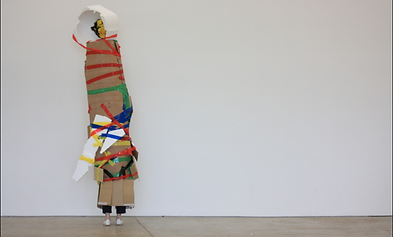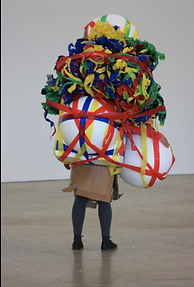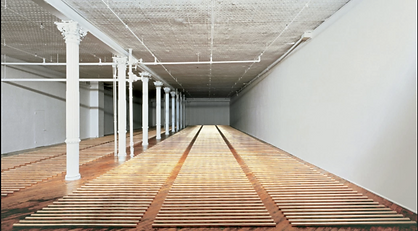NANDO MESSIAS
FLORENCE PEAKE
Florence Peake is a performance artist that uses art materials, found objects and her moving body to create sculpture. Having had training in dance, Peake uses carefully orchestrated choreography to examine the possibilities of different materials in relation to a space and a body. Her work explores themes of art, dance and sculpture in a playful and witty tone.
In her piece MAKE, performed in the Yorkshire Sculpture Park in 2012 and at BALTIC in 2013, ten female performers create moving sculptures through choreographed and synchronized actions. In this performance, Peake seeks to explore the activity of installing, transporting and unpacking sculpture and wants to “reframe this hidden performative life of sculptural art objects and their carers”[1]. Peake reveals the process of producing art within her art to uncover its performative value. The performers move around the space, arranging the materials into different and interesting structures. The materials used are ones conventionally associated with packing and unpacking art objects. This includes pieces of cardboard, different coloured adhesive tape, polystyrene, Styrofoam balls and two-by-one timber of multiple lengths. As well as arranging the materials around the space in different shapes, there are also three designated performers who become part of the sculptures and are ‘packed’. They are covered in cardboard, polystyrene and tape. This performance investigates the different ways of interaction between animate and inanimate performers to create abstract sculpture.
Peake’s desire to experiment and show the process of creation is what inspires my work. The combination of different art forms in MAKE and the playfulness of the piece enable a creative space for free experimentation. I am using collected material in my piece to follow on Peake’s investment in finding artistic and performative value in the mundane. I wish to use materials not conventionally linked to art making in order to test the possibilities of such materials that can be overlooked. Peake uses long thin planks of wood to create large-scale and linear sculptures whilst also moving around the space to analyse the body’s movement in relation to such objects. I am adopting this concept by exploring the possibilities and limitations of my own body when faced with artificially-made straight objects, such as planks of wood and metal pipes.
In MAKE, sound is also an important element of the piece. We can hear the noise of the tape echoing in the space as well as the footsteps of the performers. I want to explore the sound different materials make when put into contact with each other and with the human body. Through sound and shape I wish to expose how sculpture can control and transform a space. I wish to examine the action of construction and deconstruction, as Peake does through the ‘packing’ and ‘unpacking’ of certain performers. MAKE is composed of a continual cycle of making and destroying sculpture, this is how I seek to expose concepts of never-ending change and transformation. I am repeatedly creating and then disassembling structures for an extended amount of time.
[1] David Briers, ‘Florence Peake: MAKE’, Art Monthly, 357 (2012), p. 37.




WALTER DE MARIA
Walter De Maria is an American artist, who’s work was on the front line of several art historical movements of the twentieth century, such as conceptual, installation and land art. De Maria uses repeated geometrical shapes within various landscapes to create his sculptural installations. Through his use of particularly simple elements and themes, “he creates a greater depth of perceptual understanding”[2]. De Maria creates spaces in which the conceptual surpasses anything else.
His piece The Broken Kilometer, created in 1979 can still be seen at 393 West Broadway in New York City. De Maria’s installation piece is constituted of 500 round, solid brass rods placed across the floor of an open room with Corinthian columns. There are five parallel rows of 100 rods. Each rod measures exactly two meters in length and five centimetres in diameter. The space between each rod increases by five millimetres with each consecutive space. Therefore, the first rods are 80 millimetres apart and the last ones are 570 millimetres apart. The complete installation measures 125 feet long and 45 feet wide, and if placed end to end, the rods would extend to exactly one kilometre.
Several elements from De Maria’s installation have inspired my work. For example, the use of symmetrical and linear objects. Linear shapes can be representative of distance, as well as time and rigidity, which are elements I wish to focus on. His use of simple and minimalistic material allows for a more complex perception of basic objects. I wish to explore this idea of complex within the mundane within my own work. In his work he interrogates the use of space and landscape and the way they can be perceived. He has pushed boundaries of what a typical white cube space can allow. Several of his installations are directly linked to natural landscapes and the outdoors. I wish to create a space that incorporates the outdoors as well as the indoors, through the use of collected material and their specific placement. In another way, De Maria brings the artificial into the natural world, by placing his geometrical sculptures outside, however I seek to reflect on the natural body in relation to geometrical objects.
Walter De Maria’s works are highly calculated and measured to create perfect symmetry. I wish to explore these notions of symmetrical perfection in relation to the limitations of the human body. By using artificially made straight objects and comparing them to my own body, I wish to expose these opposites through the fluidity of movement and the harsh rigidity of the material. In my work I am demonstrating how my body cannot fulfil symmetrical perfection without the help of technology or mathematics. My body is not perfectly straight in any way.
[2] ‘The Art Story: Modern Art Insight’, <http://www.theartstory.org/artist-de-maria-walter-artworks.htm> [accessed 25 February 2017].

